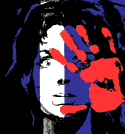
|
 |
MARIO BAVA:
THE ILLUSION OF REALITY
ARTICLE BY ALAIN SILVER AND JAMES URSINI
PAGE TWO OF TWO []
Even as he gives the audience additional information about the characters through light and color, Bava could also manipulate mythic and social codes. Even if the plots are predictable, the staging of individual events compels a sense of anxiety in the viewer; and sometimes the events themselves are unexpected. To this end, Bava’s mise-en-scene encouraged misreading. For instance, the two formidable leashed mastiffs which accompany Katia when she is first seen in Black Sunday suggest, incorrectly, that she might be the sorceress resurrected with two bestial familiars.
 | Katia (Barbara Steele) makes her first appearance accompanied by two mastiffs in Black Sunday.
[click photo for larger version] |
Inversely, there is the plot twist at the conclusion of Planet of the Vampires (Terrore nello Spazio, 1965). When the astronauts seen throughout the film are revealed to be aliens to an audience that must have assumed from their speech and appearance that they were human, the effect is inescapable but not very profound. There is a more complex use of misreading in Hatchet for the Honeymoon (Il Rosso Segno della Folia, 1969). The character psychology of the film seems obvious enough from the first glimpse of the protagonist’s secret room, full of mannequins in bridal gowns, toys, and other artifacts through which he attempts to recapture the innocence of his childhood.
The overt "key" to his psychopathology is the elaborate ritual by which he lures fashion models to their deaths. Unlike the serial murders of models in Bava’s earlier Blood and Black Lace (Sei Donne per l’Assassino, 1964), the designer/killer in Hatchet for the Honeymoon is revealed in the introductory scenes. His "motifs," the childish music box theme which he plays while seducing his victims or his Oedipal dreams of his own mother’s murder on her wedding night, initially suggest a "classic" disturbance of emotional trauma and repressed sexuality redirected into uncontrollable outbursts of violence. However, Bava altered the expressive meaning of these clichéd motifs by disclosing from the first the extent to which the central figure is aware of the symbolic nature of his behavior. As he remarks in voice-over after the title sequence killings, while he examines his face in a train compartment mirror, "No one would think to look at me that I am completely insane." This awareness at least partially deconstructs the traditional symbols and the false, social assumptions that underlie them.
| | 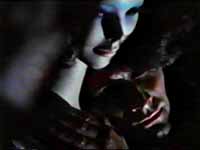 | 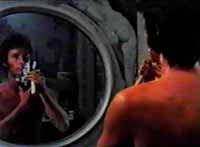 | | Left: A man and his mannequin, from Hatchet for the Honeymoon. Right: "No one would think to look at me that I am completely insane." From Hatchet for the Honeymoon. |
The perversely Freudian touches--such as the burnt bread popping out of the toaster when the protagonist argues with is wife over his sexual disinterest in her--set a tone that is satirical at first. But as the killer is overpowered by his own aberration, they also suggest the breakdown of his control. He violates the criminal pattern he has set for himself, the pattern in which he feels insanely secure, by attacking his wife. The immediate result is that he is almost caught in the act. The long-term effect is that he is now plagued by his wife’s vindictive ghost. As in earlier pictures, Bava did not choose to clarify whether this haunting is genuine or imaginary. The schizophrenia of the protagonist is established in the opening scenes, in which the character as a young boy lurks outside a train compartment while his adult self enacts the English-language title sequence and attacks some newlyweds with an ax. As the movie progresses, his disturbance overwhelms both his rational self and the film’s imagery.
A single cut from the murderer’s subjective viewpoint to an objective angle in Hatchet for the Honeymoon may express the same dichotomy between reality and illusion as an entire, elaborate set piece, such as the visit to the oracle in Hercules in the Haunted World. On some occasions, Bava might insert a ritualistic archetype merely to serve the mechanics of plot: for example, the black helmet worn by Rurik in Knives of the Avenger (Raffica di Coltelli, 1967), which conceals his face when he rapes his enemy’s bride. But most often these devices have an expressive as well as narrative value. The masks of the oracle Medea or the sorceress Asa may, like that of Rurik, conceal their identities. But masks are also larger-than-life, and the characters who wear them take on a protean aspect that is both figurative and melodramatic outside the context of the story line.
The extent to which Bava’s mise-en-scene is calculated to use genre expectations and elicit particular viewer responses is most easily analyzed in his mysteries and costume films. In the former, we don't see detective heroes methodically stripping away the layers of deception created by the criminals; instead, either the criminals themselves or the potential victims are the main characters. Neither the methods of the police nor the intricacies of the plot are as significant as the underworld of deviant behavior, like the ambiance of film noir, which criminals and victims cohabit. The long pursuit through the rural streets and alleyways in Baron Blood and the opening murder in the night mist of a city park in Blood and Black Lace are typical. Figures are forced to flee from obscure assailants, past isolated street lamps or lighted windows that offer no safety and across dim nightmarish landscapes that would, in daylight, seem perfectly ordinary and unfrightening. Even inside a locked apartment, as in the second episode of Black Sabbath ("The Telephone"), a woman may be so unnerved by a voice coming through a receiver that the sound of telephone ringing is suddenly louder and more menacing that a gun shot.
 | A caller threatens violence in "The Telephone" episode of Black Sabbath.
[click photo for larger version] |
Such visual and aural statements can have a multiplicity of keys. First, they are direct stagings of suspense sequences, using lighting, opticals, and cuts to enhance viewer apprehension. Second, they externalize the disturbed interior states of the characters. Finally, they are non-specific metaphors for either a noir-style underworld, as in The Evil Eye or Blood and Black Lace , or in the supernatural films, a chaotic, almost formless universe somewhere beyond the boundaries of normal, material reality in which ordinary persons may inadvertently stumble, as in Black Sunday or Kill, Baby, Kill. Even in the costume films, which antedate the "sword and sorcery" genre, Bava worked against a type that relies on a hero of preternatural strength or special martial ability. The title figure of Hercules in the Haunted World is strong but by no means indomitable and requires the assistance of legendary companions to complete his mission in the underworld. The Viking heroes of Erik the Conqueror and Knives of the Avenger are strong warriors but their mythic aspect is understated. Just as the non-criminal figures of the modern films, these heroes may be placed in fateful situations by exterior powers, or as Rurik ruefully observes in Knives of the Avenger, "Odin decides what our destinies are."
Bava’s modern day thrillers conform to a somewhat sexist mythology of their own, which can be more rigid that the pre-established context of the costume pictures. The beautiful young models in Blood and Black Lace, episode two ("The Telephone") of Black Sabbath, Hatchet for the Honeymoon, and Five Dolls for the August Moon (Cinque Bambole per La Luna d’Agosto, 1969) are all ostensibly normal people. Yet their very profession suggests a commitment to surface values and appearances. They are perfect victims for Bava’s patriarchal narratives because they epitomize the complacency and superficiality of the modern world. Confronted with a para-normal threat, be it a ghost or a psychopath, these human mannequins are ill-equipped to save themselves.
 | The Baron pursues Eva (Elke Sommer) in Baron Blood.
[click photo for larger version] |
In Baron Blood, Bava also added another layer of contrast between the modern characters and objects and the architecture, antiques, and icons of the past. The "haunted" castle of Baron Blood is a maze of stone and iron. Through Gothic arches and down spiral staircases into dungeons decked with iron maidens and racks, characters descend from a modern world into the chambers of the past where ancient horrors still lurk. Bava reinforced the disequilibrium with his usual off-angled shots, spinning pans, and cross-zooms, sometimes dizzyingly repeated as many as four times, and straight cuts from tight long lens close-ups to distorted wide angles of the old castle’s expanses. Sustained sequences such as the reanimated Baron’s pursuit of Eva through the fog-enshrouded passageways and courtyards at night is vintage Bava, but so are subtler visualizations. When the child Gretchen flees from an unseen presence in the woods, the camera assumes the pursuer’s point of view. Then at a pivotal moment, a low angle captures Gretchen clambering up a gully and over a ridge just before the Baron’s black cape cuts across the foreground and blots out the frame. Decor, costuming, and optical effects work with camera movement in the seance scene to invoke Elizabeth Holly. A tight shot on an amulet in the medium’s hand slowly focuses. Then a zoom and dolly shot are combined to pull back to a wide angle, revealing the other characters around a pyre by the monolith where Holly was burned as a witch by the Baron. Finally, her spirit appears, superimposed over the flames at frame right and speaking through the medium at frame left.
| | 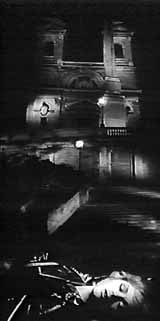 | | The heroine of The Girl Who Knew Too Much faints on the streets of Rome |
Ironically, Bava could portray those characters whose distrust of every shadow and stray sound helps them survive as semi-comic and slightly paranoid. The heroine of The Evil Eye becomes such a figure in self defense. After witnessing the death of a stabbing victim, she faints and comes to her senses in a hospital where she has been admitted for chronic alcoholism. Her story is dismissed as a case of delirium tremens. This sets in motion a central series of scenes in which the significant details are designed to be misread. In a visit to a rural locale and an antique Roman site, ominous low angles and traveling shots follow her while she tries to evade a suspicious-looking man. He catches up and reveals that he merely wants to pick her up. In a later sequence, she constructs a maze of thread and talcum powder in a living room to trip up the knife-wielding killer she believes is stalking her. She succeeds in almost breaking the neck of a smitten young doctor trying to cure her delusions. In a final scene, after the killer has been caught, she and the doctor are riding a funicular railway and witness a jealous husband shoot his wife and her lover. He is aghast; but, because she has promised him to forget all about murders, she refuses to admit seeing anything. It is simultaneously one of the most humorous and one of the darkest endings in Bava’s work.
Seriously or satirically, all of Bava’s films question the permanence of commonplace reality. Given this recurrent theme, there are no restrictions on figurative potential of his visual usage. The catalogue of Bava’s style is as broad and eclectic as the genres in which he worked. He may use a long take to build dramatic tension, as in the fashion show which is prelude to the first murder in Blood and Black Lace. He may use a low angle on a figure to suggest dominance, as in the initial encounter between Rurik and the villainous Augen in Knives of the Avenger. He may use montage for a "traditional" symbolic rendering, as in the third episode ("The Wurdalak") of Black Sabbath, cutting from a vampire embracing her lover, to her undead family, to the victim’s frenzied horse, whinnying, rearing up, and breaking his tether to flee. An isolated detail which is used for suspense in one film, such as the killer peering through a curtain in Baron Blood, may be transmuted for comic effect in another, as in the eyes of a portrait that seem to leer at the heroine of The Evil Eye as she undresses. The make-up and special effects that give a photographic reality to the revivification of the vampire in Black Sunday are reapplied sardonically in Danger: Diabolik (1967), where exaggerated costuming and matte shots make the characters stand out in relief, like comic-book figures. Even the most bizarre images may be used to evoke a frisson, as when the dead astronauts stand up in their shallow graves and tear out of their plastic shrouds in Planet of the Vampires, or laughter, as in the close-up shot of the supposedly dead Diabolik encased in translucent gold and winking at his female accomplice.
| |  | 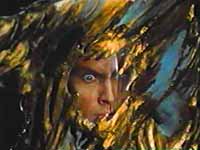 | | Left: Dead astronauts rise from their graves in Planet of Vampires. Right: Superspy Diabolik becomes covered with gold in Danger: Diabolik. |
In many instances, Bava had to rely on visual invention to conceal his limited budgets. To create a raid on a Viking village without scores of extras, he assembled a montage of individual spear thrusts, death blows, figures falling back towards camera, and hurled firebrands, all moving in the same direction and ending with a panning long shot as the last of the raiders rides out of the smoldering remains of the village. In other instances, he expended a considerable amount of production value merely to add a novel touch to a mythic form. For the duel in a huge, torch-lit cave in Erik the Conqueror, Bava used an establishing long shot and a prologue in which the participants must forge their own weapons, delaying and enhancing the action of the combat itself. In moments of narrative terror the montage, zooms, cross-traveling, acute angles et al. are typically supported by equally unusual sounds. If the image was the nexus of metaphor for Bava, the soundtrack is reserved for the literal discord. The noises that add counterpoint to music or dialogue are part of any Italian foley artist's bag of tricks, but Bava's positioning gives them an edge. The underscores may be as insistent as Bava's accelerated zooms, forcing the spectator into a fixed perspective. In the Les Baxter re-scores for Bava’s Black Sunday and Baron Blood, the drums, cymbals, and brass constantly assault the circular measures of the strings with dissonant chords. An eerie plaintive flute or a few piano keys find their voice for a few bars then are displaced by insistent timpani. In the original Stelvio Cipriani score for Baron Blood, a pre-disco main title theme gave a pop/travelogue feel to the shots of a jumbo jet flying and setting down. The irony of jingle-like melodies with a lilting chorale backup opening a horror film was an aural equivalent to some of Bava’s visual jokes. The mutable and animated reality of Bava’s films may even extend to props, as in the claw-like knife shaped like the fingers of a skeletal hand in Hercules in the Haunted World or the whip in What, which writhes in the surf when Nevenka is raped by her ghost lover. That same whip curls and chars like a living thing writhing in agony when the lover’s corpse is consumed by flames.
 | A whip writhes in a fireplace in the final camera shot from The Whip and the Body.
[click photo to view an animated GIF of this scene (3 frames, 28KB)] |
Although the visual style of his motion pictures may be unmistakable or even unique (and on those several productions where he receives credit under a pseudonym that style is Bava’s real and only signature), no director can completely transcend his narrative material. For Bava, who labored exclusively in a system where even A-budgets were small, where multiple cameras and post-synchronization of dialogue were not options but standard operating procedures, where shooting schedules were short, and post schedules even shorter, the odds against excellent results were always even greater. That the sea battle in Erik the Conqueror, staged in a studio tank with two prows, a fog machine, and speed rail, should be much more convincing than the clash of custom-made miniatures in Ben Hur is a tribute to Bava the technician. That one man working against such limitations could become one of the most striking of genre stylists may seem hard to believe. The proof, beyond the often stilted, dubbed performances, creaky sound effects, and tinny music, beyond the panned and scanned, retimed and sometimes reedited videos, is in the images themselves. No matter how feeble the character development may be or how far-fetched the plot, Bava’s visual style is the cornerstone of a sensory package that envelops the audience and sends them on a journey into the undiscovered country.
Alain Silver is an independent film producer and sometime critic, who has
previously written about Kiss Me Deadly for Images. His books with James
Ursini, who is a lecturer and educator, include The Vampire Film, More Things
Than are Dreamt Of, David Lean and his Films, and The Noir
Style. Together they edited Film Noir Reader and the most recent edition of Film Noir: An Encyclopedic Reference.
|
 |